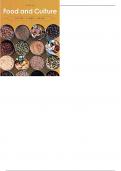Examen
Food and Culture 6th Edition by Pamela Goyan Kittler - Test Bank
- Grado
- Institución
- Book
Test Bank For Food and Culture 6th Edition by Pamela Goyan Kittler Test Bank1 for Food and Culture 6e Chapter 3: Intercultural Communication Multiple Choice Questions 1. What characteristics represent the “tip of the iceberg” in the iceberg analogy used to describe communication? a. Re...
[Mostrar más]



